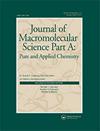一种基于透明质酸的前药,具有聚集诱导发射,用于药物传递和细胞成像
IF 2.4
3区 化学
Q3 POLYMER SCIENCE
Journal of Macromolecular Science Part A-Pure and Applied Chemistry
Pub Date : 2023-10-10
DOI:10.1080/10601325.2023.2265961
引用次数: 0
摘要
摘要一种新型药物分子(R6)与透明质酸(HA)偶联形成具有聚集诱导发射(AIE)特性的ph响应前药。由于其两亲性,前体药物可以在水溶液中自组装成纳米颗粒(NP)。因此,这种配方引起了位于NP核心的R6部分的AIE。该聚合物可在肿瘤微环境(TME)酸性条件下释放药物(72 h后释放99%),并在生理ph下保持稳定。此外,NP的AIE荧光信号可用于细胞成像。透明质酸外壳可以靶向癌细胞中过表达的CD44受体,这使得NP具有活性靶向特性。前药对小鼠乳腺癌细胞系4T1有毒性作用,对L929成纤维细胞无害。荧光显微镜图像证实了NP在4T1细胞中的成像能力。HA-R6聚合物前药有望成为一种通用的ph敏感药物输送平台。关键词:透明质酸;药物;药物传递;聚集诱导发射成像致谢感谢国立台湾科技大学(NTUST)和化学工程系对本项目的支持。化学表征和细胞研究使用了台湾科技部基金(NSTC 111-2221-E-011-025)。Hyluronic acid由NSTC 109-2222-E-011-004基金购买。披露声明作者声明没有与之竞争的经济利益。本文章由计算机程序翻译,如有差异,请以英文原文为准。
A hyaluronic-based prodrug with aggregation-induced emission for drug delivery and cellular imaging
AbstractA novel drug molecule (R6) is conjugated to hyaluronic acid (HA) to form a pH-responsive prodrug with aggregation-induced emission (AIE) property. Owing to its amphiphilic nature, the prodrug could self-assemble into nanoparticles (NP) in an aqueous solution. This formulation thereby gave rise to AIE of the R6 moieties which resided in the NP core. The polymer could release the drug at the tumor microenvironment (TME) acidic condition (99% release after 72 h), while remaining stable at the physiological pH. In addition, fluorescence signals by AIE from the NP could be used for cellular imaging. The hyaluronic acid shell can target the overexpressed CD44 receptors in cancer cells, which gives the NP active targeting property. The prodrug showed toxicity against the mouse breast cancer cell line 4T1 while being harmless to the L929 fibroblast cells. Fluorescence microscopy images confirmed the imaging ability of the NP in 4T1 cells. The HA-R6 polymer prodrug promises to be a versatile pH-sensitive drug delivery platform.Keywords: Hyaluronic acidprodrugdrug deliveryaggregation-induced emissionimaging AcknowledgmentsWe would like to express their gratitude to National Taiwan University of Science and Technology (NTUST) and the Department of Chemical Engineering for their support to this project. For the chemical characterization and cell studies, Taiwan Ministry of Science and Technology funding (NSTC 111-2221-E-011-025) was used. Hyluronic acid was purchased from the NSTC 109-2222-E-011-004 grant.Disclosure statementThe authors declare no competing financial interest.
求助全文
通过发布文献求助,成功后即可免费获取论文全文。
去求助
来源期刊
CiteScore
4.60
自引率
16.00%
发文量
61
审稿时长
3.1 months
期刊介绍:
Journal of Macromolecular Science, Part A: Pure and Applied Chemistry (JMS-PAC) is a necessary resource for academic and industrial scientists and engineers whose interests center on both synthetic and naturally occurring polymers and their applications.

 求助内容:
求助内容: 应助结果提醒方式:
应助结果提醒方式:


